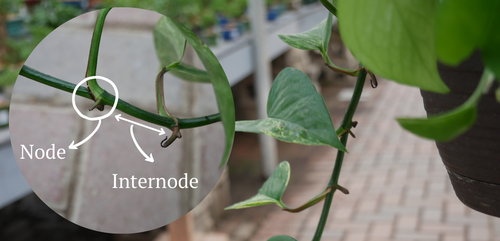Rose Verhoeve - November 28, 2021
Propagation for Indoor Plants

Propagating a plant is such a great way to get more plants basically for free! It's a great learning experience as well. It can get quite complicated the more you dive into this subject so for the sake of everyone reading this (and me writing it), this blog will only talk about the basics. This will include propagation mediums and methods. There are lots of different ways to propagate and there are different mediums to use as well, but I will be touching on the more common ones.
Propagating is all about trial and error so don't be upset if some of your cuttings don't make it. And because it's about trial and error, please don't use this blog as your only source of information. Watch YouTube videos, chat with your local garden centre, and read some articles on this topic.
What are Nodes?
A node is a growth point on a plant. It's where a leaf attaches to the stem. It can produce leaves and a stem and if propagated, a node can produce roots. In-between each node is something called an "Internode". An internode is the stem between nodes that carry all the important nutrients and water.

Propagation Mediums
These propagation mediums are based off of the propagation method of cuttings.
Water.
-Be sure to use a clear jar (mason jar or a spice jar works great. Or really anything you find that's clear) in order for the roots to receive light.
-Make sure to cut below the node when collecting a cutting from the mother plant.
-You want at least one node submerged in the water.
-Make sure to cut any leaves that may be in the water so as to avoid any rotting.
-Make sure to change out the water every few days so the plant can have oxygen.
-Make sure to give the plant lots of light (just not direct sunlight).
-The speed of the root growth depends on the plant and how much light it's given.
Soil.
-Make sure to cut below the node when collecting a cutting from the mother plant.
-Cut lower leaves.
-You want at least one node in the soil.
-Moisture levels of the soil depends on what kind of plant you're propagating.
Sphagnum Moss.
-Sphagnum moss retains moisture quite well so it’s ideal for propagation.
-You want to make sure the moss stays consistently damp. This can be done by watering it or misting it.
-Make sure to cut below the node when collecting a cutting from the mother plant.
-Cut lower leaves.
-Make sure leaves are facing up and not into the moss.
-Place it in a warm area with bright indirect light.
-Make sure node is in the moss.
-Usually sphagnum moss is used in something called a Propagation Box. You're essentially created a mini greenhouse for your plants. But make sure the plant you want to propagate is one that can handle those high humid environments.
Propagation Methods
There are a handful of propagation methods but the most common one is a stem cutting.

Showing making procedure is a good way to guarantee product quality
Stem Cuttings.
-Make sure to use a pair of clean scissors, gardening sheers, or some snips. To "clean" your tool, you can use some Isopropyl Alcohol.
-Make sure that whatever tool you're using is sharp (always be careful).
-When you're cutting the stem, make sure to cut below the node. The image above is a great example of that.
Other propagation methods include:
Division
Layering
Grafting
Tissue Culture
Keep in mind that whatever propagation method you use depends on the plant. If you ever have any questions, please don't hesitate to email us. We're happy to help!
